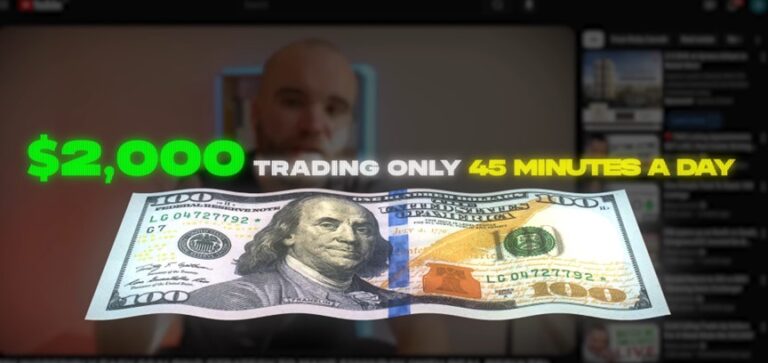Introduction to the Simple Scalp Trading Strategy
I make $2,000 per day trading this stupidly simple scalping strategy. It’s so stupidly easy that even a monkey could trade it. Using the strategy I developed, I withdrew $188,000 from my live funded FXI prop account all last week, and so far this week, I’ve made over $28,000 on my Asend X prop funded account. I’ll be withdrawing that in 2 days from now.
In this video, I’m going to show you the three easy steps to executing the strategy and making upwards of $22,000 trading only 45 minutes a day. I promise you, if you put in the work and actually test the strategy, focusing on this extremely simple trading edge, you will get funded and change your life.
The Importance of Framing Trades
This first part is vital to understanding how to frame trades with the strategy. If you don’t implement it, you’re pretty much taking trades fully in the dark, yet 99% of traders overlook this part. All right, so here we are on the 4-Hour time frame. Essentially, all we’re doing is marking out swing structure. As you can see with my previous drawings, the price pushed up, retraced, and then pushed up again, taking out this high.
We only really count a swing structure once we’ve taken out a high, and the lowest part of that becomes our swing low. If you need more detail on this kind of structure, check out my previous video that came out just before this one.
Identifying Bullish Trends
Looking a bit further back, we see that the price pushed up, retraced, pushed up again, and continued the pattern. We’ve had one break, two breaks of structure. This indicates that we are now bullish, as I’ve discussed in previous videos. While I can still take trades against this trend, I am favoring longs because the 4-hour chart is clearly bullish. This is how I determine that our swing structure is bullish.
Marking Support and Resistance Zones
The most important part of this 4-hour time frame is marking out 4-hour support and resistance. How I do that is quite simple: I look for the market to retrace. When the market starts to retrace in any direction against the trend, we can add in a support zone here. This would be a resistance SL support zone. I draw that from the body to the wick, so we essentially have this body here to the top of that wick. It doesn’t need to be extremely precise.
This is a framework for us to work within, similar to how you might draw a round face and use a cross to position the eyes and mouth. We are creating a framework to trade within, waiting for the price to break through and take a long trade if we are down at the bottom of this zone.
Analyzing Lower Time Frames for Trade Execution
Once we’ve marked out these support and resistance zones, we can go down to lower time frames and dissect the trades that could potentially set up within this framework. We want to trade within these zones and avoid taking trades that have no room to move, heading straight into a brick wall. This framework guides us in taking higher probability trades on lower time frames.
Key Elements for Effective Trading
Now, let’s dive into the core of this strategy. This next step might seem simple, but it’s crucial for framing trades that are safe to be in. Here’s what we looked at today: using the same framework drawn out on the 4-hour chart, we analyzed price action. We wanted to avoid taking shorts into a brick wall. For shorts, we need the price to clear this zone first so we can take shorts off the structure created down here. The higher probability trade would be longs because we now have the structure up here, the extremity of the most recent 5-minute structure.
Zone Breakouts and Rejections
How I draw these zones and determine which to use is simple: I won’t mark up any zones within this block as they are within a range. We want price to clear the range, with the breakout occurring at the edge of the range. If we look similarly, this is the bottom of the range, and this would be my support zone that I need to see broken to go short. Once it does, we can see price retest and continue lower. This was my forecast for today, and the trade worked out well.
Real-Time Trading Considerations
The final piece of the puzzle is to trade within the New York session, which starts around 2:30 p.m. London time, 9:30 a.m. Pacific time, and 3:30 p.m. South African Standard Time. One key feature of this strategy is that you cannot take a trade on the first candle print.
We must wait for the first 5 minutes to finish. After this, we look for a break and closure outside our marked zone. If we see a liquidity grab but no closure, we wait. The market often takes liquidity from those buying on the break, so we wait for the retest after closure.
Utilizing the 50 SMA for Trade Decisions
The 50 SMA (Simple Moving Average) is also important. You should add the 50 SMA indicator with a length of 50 and method SMA. This helps determine the direction on the 5-minute chart. We only take buys when we are above the 50 SMA and sells when below. The 50 SMA often acts as a support or resistance point, so we want it to be a barrier between our entry and stop loss. It should also be pointing in the direction of the trade.
Entry and Exit Strategy
Once we have our 5-minute zone marked and breakout occurred, we need to know where to enter. We look for a rejection of the zone. We do not just set a limit order; we wait for the price to tap, hesitate, and then reject the zone.
This saves us from entering trades where price might smash through without hesitation. I missed the initial entry but joined once price rejected the zone again. My stop loss was a maximum of 20 pips, and the take profit was set at a 1:2 risk-reward ratio, aiming for about 40 pips.
Conclusion and Practical Application
Price continued to break through significantly, hitting take profit. On my live funded account, I took profit at a key level. This strategy is different from others I’ve traded because it requires real-time candlestick analysis, which bar replay doesn’t fully represent. To test this strategy, live testing on a demo account or a small funded account is essential.
Trade the strategy for at least 2 months, collect data, and see it work for you live. Join me on our live Discord streams to see this strategy in action every day at the New York Stock Exchange open. It’s free to join, and you can be part of a community of like-minded traders.


